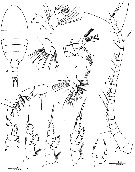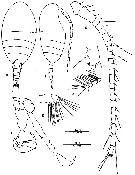|
|
 |
Fiche d'espèce de Copépode |
|
|
Calanoida ( Ordre ) |
|
|
|
Clausocalanoidea ( Superfamille ) |
|
|
|
Stephidae ( Famille ) |
|
|
|
Stephos ( Genre ) |
|
|
| |
Stephos rustadi Strömgren, 1969 (F,M) | |
| | | | | | | Ref.: | | | Strömgren, 1969 (p.1, figs.F,M); Bradford-Grieve, 1999 a (p.25, Table 1: Rem.); S.Y. Moon & al., 2015 (p.31: Rem.); Kos, 2016 (p.34, figs.F,M, Rem.) |  issued from : T. Strömgren in Sarsia, 1969, 37. [p.2, Fig.1]. Female (from Lysefjorden: south of Bergen): habitus (lateral right side).
|
 issued from : T. Strömgren in Sarsia, 1969, 37. [p.3, Fig.2]. Female: A, habitus (dorsal); B, Md; C, Mx2; D, A2; E, A1; F, Mxp; G, Mx1; H, P1; I, P2; J, P3; K, P4; L, P5. Nota: Caudal rami with 2 strong and 1 small seta. Exopod 5-segmented, longer than endopod, with 3 terminal setae and 6 setae along the inner edge. masticatory edge of Md with 9 teeth, the outermost stronger, and the innermost more slender than the others; exopod 4-segmented with 6 setae; endopod 2-segmented, 2nd segment with 8 terminal setae.
|
 issued from : T. Strömgren in Sarsia, 1969, 37. [p.4, Fig.3]. Male: A, habitus (dorsal); B, idem (lateral right side); C, A1; D, Mxp; E, Mx2; F, P5. Nota: P1-P4 swimming legs as in female. Right leg of P5 longer than the left, with 4 segments; the last two segments very elongated, the last ending in a finely serrated claw-like structure. Left leg with 5 segments, the last segment with two heavy hook-like processes, the larger one with a secondary hook-like process, neary perpendicular to its base. segments
| | | | | Ref. compl.: | | | Holmes, 2001 (p.53, Rem.) | | | | NZ: | 1 | | |
|
Carte de distribution de Stephos rustadi par zones géographiques
|
| | | | | | | Loc: | | | Norway (west coast: Lysefjorden), North Sea, S Ireland (Lough Hyne) | | | | N: | 3 | | | | Lg.: | | | (560) F: 0,58-0,76; M: 0,58-0,64; {F: 0,58-0,76; M: 0,58-0,64} | | | | Rem.: | For Strömgren (1969, p.7) the species was found only in water with less 1.1 ml O2/l, either day or night, it may be assumed that this species tolerates and possibly finds optimal conditions in habitats with low oxygen content. Such an adaptation to low oxygen concentrations may explain its dominance over other copepods in the area.
After Bradford-Grieve (1999 a, p.25) this species belongs to type IV (see Genus Stephos). | | | Dernière mise à jour : 31/01/2019 | |
|
|
 Toute utilisation de ce site pour une publication sera mentionnée avec la référence suivante : Toute utilisation de ce site pour une publication sera mentionnée avec la référence suivante :
Razouls C., Desreumaux N., Kouwenberg J. et de Bovée F., 2005-2025. - Biodiversité des Copépodes planctoniques marins (morphologie, répartition géographique et données biologiques). Sorbonne Université, CNRS. Disponible sur http://copepodes.obs-banyuls.fr [Accédé le 17 décembre 2025] © copyright 2005-2025 Sorbonne Université, CNRS
|
|
 |
 |





